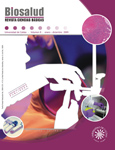Autores/as
Resumen
Existe un cuestionamiento permanente acerca del fluido ideal para el análisis de carnitina y acilcarnitina por medio de la espectrometría de masas en tándem. El presente estudio evalúa el porcentaje de carnitina y acilcarnitinas en glóbulos rojos y la relación con el contenido de carnitina y acilcarnitina en la sangre, plasma y suero. Se centrifugaron muestras de sangre humana, se extrajeron plasma y suero, y se lavaron los glóbulos rojos con diferentes soluciones isotónicas. Se resuspendió el pellet en PBS para la preparación de tarjetas y análisis por espectrometría de masas en tándem. Se encontró que la carnitina y las acilcarnitinas de cadenas corta, media y larga, permanecen en los glóbulos rojos en porcentajes promedio de 43,4; 48;49; y 70% respectivamente. Se encontró una diferencia significativa entre los niveles de carnitina y acilcarnitina en la sangre comparado con sus niveles en plasma o suero (p<0,05). Dada la asociación de la carnitina y las acilcarnitinas con los glóbulos rojos, parece ser que ni la plasma ni el suero son el material ideal para el análisis de carnitina y acilcarnitinas.
Citas
Millington DS, Kodo N, Terada N, Roe D, Chace DH. The analysis of diagnostic markers of genetic disorders in human blood and urine using tandem mass spectrometry with liquid secondary ion mass spectrometry. Int J Mass Spect Ion Proc 1999; 111:211-228.
Levy PA. Inborn errors of metabolism: part 1: overview. Pediatr Rev 2009;30(4):131-137.
Sahai I, Marsden D. Newborn screening. Crit Rev Clin Lab Sci 2009;46(2):55-82.
Chalcraft KR, Britz-McKibbin P. Newborn screening of inborn errors of metabolism by capillary electrophoresis-electrospray ionization-mass spectrometry: a second-tier method with improved specificity and sensitivity. Anal Chem 2009;81(1):307-314.
Artuch Iriberri R, Moreno J, Puig R, Quintana M, Montero R, Ormazábal A, Vilaseca M. Laboratory diagnosis of rare diseases. An Sist Sanit Navar 2008;31(Suppl 2):91-103.
Agarwal RL, Muranjan MN. Diagnostic practice for organic acidemias: barriers to early diagnosis. Arch Dis Child 2008;93(11):1000.
Vianey-Saban, N. Guffon, F. Delolne, P. Guibaud, M. Mathieu, P. Divry. Diagnosis of inborn errors of metabolism by acylcarnitine profiling in blood using tandem mass spectrometry. J Inher Metab Dis 1997;20:411-444.
Johnson JW, Lee MS, Lee MR, Yost T. Triple Quadrupole MS/MS. In: Mass Spectrometry in Biomedical Research. London; 1986. pp. 459-457.
Millington DS, Chace DH. Carnitine and acylcarnitines in metabolic disease diagnosis and management. In: Desiderio DM, ed. Mass spectrometry: clinical and biomedical applications, vol. I. New York: Plenum Press; 1992. pp. 299-316.
Libert R, Van Hoof F, Thillaye M, Vincent MF, Nassogne MC, Stroobant V, et al. Identification of new medium-chain acylcarnitines present in urine of a patient with medium-chain acyl-CoA dehydrogenase deficiency. J Inher Metab Dis 1999;22:9-18.
Y. Shigmatsu Y, Hata I, Nakai A, Kikawa Y, Sudo M, Tanaka Y, et al. Prenatal Diagnosis of Organic Acidemias Based on Amniotic Fluid Levels of Acylcarnitines. Pediatr Res 1996;39:680-684.
M.S. Rashed MS, Ozand PT, Bennet MJ, Barnard JJ, Govindaraza DR, Rinaldo P. Inborn errors of metabolism diagnosed in sudden death cases by acylcarnitine analysis of postmorten bile. Clin Chem 1995;41:1109-1114.
Arduini A, Mancinelli G, Radtti GL, Dottori S, Molajoni F, Ramsay RR. Role of carnitine and carnitine palmitoyltransferase as integral components of the pathway for membrane phospholipid fatty acid turnover in intact human erythrocytes. J Biol Chem 1992;267:12673-12681.
Arduini A, Tyurin V, Tyuruna Y, Arrigoni-Martinelli E, Molajoni F, Dottori S, et al. Acyl-trafficking in membrane phospholipid fatty acid turnover: the transfer of fatty acid from the acyl-L-carnitine pool to membrane phospholipid in intact human erythrocytes. Biochem Biophys Res Commun 1992;187:353-358.
Borum PJ, York CM, Bennet SG. Carnitine concentration of red blood cells. Am J Clin Nutr 1985;41:653-656.
Schoderbeck M, Auer B, Legenstein E, Genger H, Sevelda P, Salzer H, et al. Pregnancy-related changes of carnitine and acylcarnitine concentrations of plasma and erythrocytes. J Perinat Med 1995;23:477-485.
Mares-Perlman JA, Farrel PM, Gutcher GR. Changes in erythrocyte and plasma carnitine concentrations in preterm neonates. Am J Clin Nutr 1986;43:77-84.
Reichmann H, van Lindeneiner N. Carnitine analysis in normal human red blood cells, plasma and muscle tissue. Europ Neurol 1994;34:40-43.
Vessey DA, Chen WW, Ramsay RR. Effect of carboxylic acid xenobiotics and their metabolites on the activity of carnitine acyltransferases. Biochem J 1991;279(Pt 3):895-897.
Ramsay RR, Arduini A. The carnitine acyltransferases and their role in modulating acyl-CoA pools. Arch Biochem Biophys 1993;302:307-314.
Igal RA, Wang P, Coleman RA. Triacsin C blocks synthesis of glycerolipids and cholesterol esters but not recycling of fatty acid into phospholidpid: evidence for functionally separate pools of acyl-CoA. Biochem J 1997;324:529-534.
Ramsay RR. The carnitine acyltransferases: modulators of acyl-CoA-dependent reactions. Biochem Soc Trans 2000;28:182-186.

 PDF (English)
PDF (English)
 FLIP
FLIP














